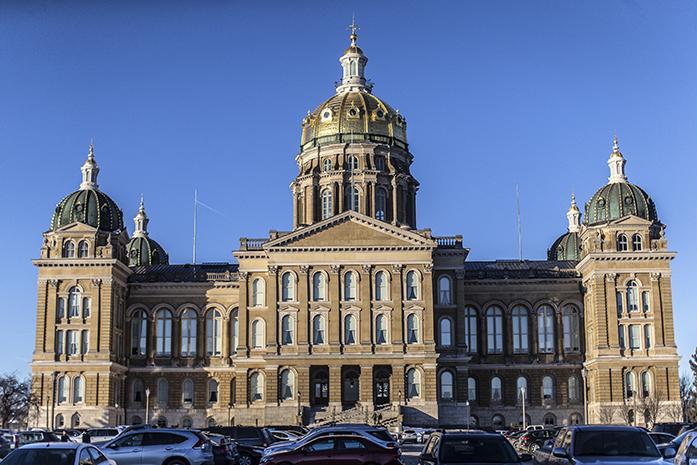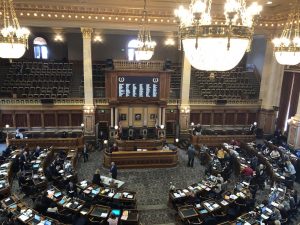Reynolds remains confident in ability to fund budget priorities
In an interview with The Daily Iowan, Gov. Kim Reynolds said sound fiscal policies will help fund proposals in her Condition of the State address.
The Iowa State Capitol is shown on Tuesday, Jan. 13, 2015.
January 15, 2019
DES MOINES — Gov. Kim Reynolds remains confident that the state of Iowa’s economy is strong.
After two years of dropping commodity prices and a turbulent trade war throwing inconsistency into Iowa’s budget revenue, Reynolds is confident her fiscal policies steady the budget ship so the midyear budget cuts of 2017 and 2018 will be kept at bay.
“Yeah, there is,” Reynolds said in response to a question about if there’s enough money in the state budget to sustain priorities she expanded upon in her address to the Legislature. “Because we’ve been very fiscally responsible in the budget that we put together, we passed policies that are growing the economy.”
In Reynolds’ fiscal 2020 and 2021 budget, she laid out plans to better fund legislation passed last year in areas including mental-health reform and workforce development, and proposed increased appropriations for other state-funded programs. She also proposed to amend the constitution to add voting rights for felons and enshrine rights for victims of crimes.
RELATED: ‘The future is now,’ Iowa Gov. Kim Reynolds says in Condition of the State address
Budget officials are expecting the next few years to end with extra dollars in the state coffers. Fiscal 2018 ended with $127 million left over, and in the current budget year, which ends June 30, there’s expected to be a $185-million ending balance. Fiscal 2021, too, is expecting funds left over.
Legislators are expected to look over Reynolds’ nearly $8 billion proposed budget over the next few months and adopt or modify Reynolds’ proposals.
Budget officials told reporters Tuesday morning Iowa is expected to take in $7.96 billion in taxpayer dollars during fiscal 2020, which starts July 1. About $7.65 billion of that revenue pie will pay for appropriations to state services and programs, an increase of $180 million from $7.47 billion in fiscal 2019.
If the Legislature adopts Reynolds’ recommendations for the 2020 budget year, programs across state government will see increases including an additional:
- $94 million for pre-K through K-12, which means a 2.3 percent increase for each student
- $46 million for higher education, including increases to college aid commission, community colleges, $18 million for the regent universities and $20 million for Future Ready Iowa
- $26 million for human services including $6.5 million in mental health added services such as access centers and 22 mobile treatment teams
- $5 million added to the courts budget, though budget officials said Reynolds isn’t considering salary increases
After tax reform passed the Iowa Legislature in 2018 session, two growth checkpoints must be met before the majority of the tax reform package can be implemented in 2023. By then, nearly $1 billion will go to the tax cuts.
Reynolds said she’s confident, too, that the budget will meet those final triggers to implement the tax cuts. She suggested that if Iowa continues to have larger-than-expected surpluses, they could potentially move up the cuts.
“If we keep moving like we are, we could potentially move them up, but we’re watching trade, we’re watching the economy,” Reynolds said. “We’ll be mindful of that as we continue forward. As I mentioned, we have some pretty good ending balances.”
RELATED: Iowa legislators still hammering out deals on tax reform, budget as the session carries on
Many Democrats agree revenue will keep up to fund Reynolds’ proposals, but some say social-service programs could still receive more.
“In some areas, yes, I think there is enough money. But we can always do better,” Sen. Liz Mathis, D-Hiawatha, said.
Mathis said she was happy with the funding increase that would go to education. In fiscal 2019, there was a 1 percent increase to the K-12 budget, but in 2020 each student would receive 2.3 percent more in funding.
“So a 2.3 percent increase, if it turns out to be that, I think that that’s adequate. Some of the other things appear a little skimpy,” she said. “Some of the things I’m looking at in the budget, when you divide it across the statewide need, it gets a little thin.”
Rep. Mary Mascher, D-Iowa City, said she was happy to see the regent-governed universities would get an increase in funding.
“The thing I was really pleased to see was the regents funding. We have not seen those kinds of increases for a long time and it has been long overdue,” she said.






